Abstract
The advancement and acceptance of new technologies often hinges on the level of understanding and trust among potential users. Blockchain technology, despite its broad applications across diverse sectors, is often met with skepticism due to a general lack of understanding and incidents of illicit activities in the cryptocurrency domain. This study aims to demystify blockchain technology by providing an in-depth examination of its application in a novel blockchain-based card game, centered around renewable energy and sustainable resource management. This paper introduces a serious game that uses blockchain to enhance user interaction, ownership, and gameplay, demonstrating the technology’s potential to revolutionize the gaming industry. Notable aspects of the game, such as ownership of virtual assets, transparent transaction histories, trustless game mechanics, user-driven content creation, gasless transactions, and mechanisms for in-game asset trading and cross-platform asset reuse are analyzed. The paper discusses how these features, not only provide a richer gaming experience but also serve as effective tools for raising awareness about sustainable energy and resource management, thereby bridging the gap between entertainment and education. The case study offers valuable insights into how blockchain can create dynamic, secure, and participatory virtual environments, shifting the paradigm of traditional online gaming.
1. Introduction
In the rapidly evolving domain of digital gaming, blockchain technology emerges as a transformative force, offering novel paradigms for player interaction and game design [1]. At its core, blockchain serves as a decentralized digital ledger, recording transactions in a secure, transparent, and immutable manner [2,3]. This technology, foundational to the new wave of web3 games, redefines the traditional boundaries of gaming, introducing concepts of true digital ownership, trustless environments, and decentralized governance [4]. As the gaming industry grapples with challenges around security, transparency, and player agency, blockchain presents itself as a compelling solution, heralding a new era of gaming experiences [5,6].
Blockchain’s efficacy in gaming is rooted in its unique technological underpinnings. Central to this are consensus mechanisms like Proof of Work (PoW), Proof of Stake (PoS), and Delegated Proof of Stake (DPoS), each playing a crucial role in transaction validation and network security [7]. PoW, known for its robust security but high energy cost [7], contrasts with PoS and DPoS, which offer more energy-efficient alternatives [8]. Moreover, the advent of smart contracts—self-executing contracts with the terms of the agreement directly written into code—revolutionizes game mechanics [9]. These contracts autonomously manage and enforce game rules, in-game asset ownership, and player interactions, ensuring a trustable, automated gaming environment [2]. In addition, the peer-to-peer nature of blockchain networks enhances the resilience and security of games by distributing data storage, thus mitigating risks associated with centralized servers [9]. This inherent features allow blockchain to be used efficiently in many different use-cases [10,11].
The GENERA Web3 Game, developed as part of our research, harnesses these blockchain attributes to create an immersive educational experience centered around renewable energy and sustainable practices [12,13]. By employing blockchain’s decentralized ledger, the game ensures data integrity and fosters trust among players, crucial for an educational tool [14]. The use of smart contracts in the game automates key aspects of gameplay and asset management, aligning with our objectives of providing a seamless, engaging educational experience [15]. Furthermore, the decentralized, peer-to-peer architecture of blockchain not only empowers players with true ownership of their in-game assets but also mirrors the collaborative and distributed nature of sustainable energy solutions, making it an apt metaphor for the game’s thematic focus. Thus, blockchain technology is not just a backend feature of the GENERA Web3 Game; it is integral to its educational mission, enhancing both the authenticity and the pedagogical value of the gaming experience [16].
This paper presents a dual-faceted exploration into the intersection of blockchain technology and serious gaming, a genre that transcends mere entertainment to include educational and training objectives [17]. Our study is situated firmly within the research genre of applied technology in gaming, utilizing a mixed-methods approach that integrates development and evaluative research methodologies.
We begin by introducing a blockchain-based card game designed to educate on renewable energy and sustainable resource management. This game is not merely an application of technology but also an experimental design endeavor in which the development process itself is examined and reflected upon. The genre of our work, therefore, can be classified as applied research in informatics with a strong component of software engineering, as we document the creation of a serious game from conception to realization, assessing both its technological underpinnings and its pedagogical efficacy [15].
Addressing the rapid advancements in blockchain, our study includes an analysis of the current state of blockchain games, aiming to provide an up-to-date snapshot of the sector’s landscape. This element of the study aims to refresh available research data, responding to the dynamic nature of blockchain technology and its applications.
Our objectives are threefold: First, we investigate the potential enhancements blockchain technology offers to the gaming industry at large. Second, we explore how these enhancements can be specifically leveraged in serious games to improve educational outcomes and user engagement. Third, we assess whether and how the incorporation of blockchain technology in our game facilitates player understanding of and engagement with both the game’s content and the underlying blockchain technology itself.
The rest of the document is structured as follows: In the ‘Related Works’ section, we explore the existing literature on blockchain gaming, establishing the foundation and context for our research. This leads into the ‘A Serious Game for Energy Transition’ section, where the design, development, and educational goals of the GENERA Web3 Game are thoroughly detailed, emphasizing its focus on renewable energy and sustainability. The ‘Results and Discussion’ section presents our key findings, including analyses of blockchain applications in gaming and insights gathered from player surveys. Finally, the document concludes with the ‘Conclusion and Future Plans’ section, summarizing the major contributions of our study and discussing its implications for the future of blockchain in serious gaming, as well as potential avenues for further research in this dynamic and evolving domain.
2. Related Works
The rapid evolution of blockchain technology has sparked a multisided exploration into its applications in various domains, one of them being the gaming industry [18]. As blockchain games expand in popularity and diversify in form and function, several pioneering studies have emerged to unpack the intricacies and potentials of this synergy [19]. These studies delve into the categorical variations [20], player perceptions [21], technical functionalities [22], and educational aspects of blockchain games [16].
A few studies have been conducted to investigate the landscape of blockchain games, categorizing them based on their characteristics and user interactions. For example, Tian Min, Hanyi Wang et al. [22] executed a comprehensive survey that focused on identifying the unique categorizations within the realm of blockchain games. They examined the market trends and classified the games into four categories: Rule Transparency, Asset Ownership, Asset Reusability, and User-Generated Content (UGC). Their observations revealed that while the Ethereum network sees a higher number of average active users in general, when it comes to blockchain games, the EOS network is more popular due to its ability to offer higher transaction volume at a significantly lower cost.
On another note, Iikka Paajala et al. [21] sought to investigate the factors that contribute to player retention and engagement in blockchain games. Their focus was on understanding the player’s perceptions and how they are influenced by blockchain’s inherent characteristics. They concluded that the nature and quality of the game significantly impact player retention. Additionally, the study raised concerns about the transparency and potential misuse of data in blockchain games. Despite these concerns, participants were enthusiastic about user-generated content and the concept of true asset ownership.
Venturing into the territory of Serious Blockchain Games, Yunifa Miftachul Arif et al. [23] came up with a unique approach by devising a tourism-based serious game powered by blockchain technology. Their focus was on how blockchain could handle transactions, providing a more immersive and educational experience for users. They conducted a series of experiments to evaluate the speed, efficacy, and precision of transactions in a blockchain environment, observing how factors such as gas price, gas limit, and data size impact these attributes. The velocity of transactions is affected by gas price, chain length, and data weight, with gas price being the primary adjustable factor for transaction speed [23]. When studying transaction success rate, the gas limit emerged as the most impactful factor. An increase in the gas limit from 40,000 to 50,000 units doubled the success rate from 40% to 80%. Regarding transaction accuracy, a series of thirty assessments were conducted, comparing estimated expenses against actual costs, and the estimations were found to be accurate 80% of the time.
Given these insights, the integration of blockchain technology into serious games, like the one developed in this study, represents an innovative leap in gaming. The current game, leveraging blockchain technology, offers a distinctive educational experience by allowing players to use renewable energy sources to power their towns. The online, multiplayer aspect of the game, developed using web technologies, makes it widely accessible and presents a unique opportunity for scientific exploration. Its educational focus is further enhanced by future updates that will introduce more features to engage players and deepen their understanding of renewable energy transitions. The game also promotes collaboration through a marketplace feature, and its research component includes a questionnaire to capture player perceptions, contributing to broader research efforts in the field like the one Iikka Paajala et al. [21] sought to investigate. The use of DappRadar for obtaining fresh data about blockchain games provides an updated perspective, adding to the research initiated by Tian Min, Hanyi Wang, and others. This game stands as a promising example of the educational and collaborative potential of serious games powered by blockchain technology.
In a similar way, Ansh Mittal et al. [24] developed an innovative online blockchain-focused serious game, known as CEBT, intending to educate the public about the fundamentals and benefits of blockchain technology. Rather than being hosted on a typical blockchain network, this game was hosted on Firebase, a cloud service offered by Google. This game served as an effective pedagogical tool, providing interactive blockchain training through an adversarial sandbox-based serious game, encouraging the widespread adoption and understanding of blockchain technology.
In summary, the fusion of blockchain and gaming is a growing field, exhibiting vast potential in diversifying gameplay, enhancing player experience, and expanding educational horizons. Critical studies, as reflected above, have underscored the variations of blockchain games, shedding light on the categorizations, the pivotal role of networks like EOS, the significance of player perceptions, and the technologically driven challenges and triumphs within transactional mechanisms. Furthermore, the development of educational blockchain games highlights the potential for this technology to transcend mere entertainment, forging pathways for enhanced public understanding and appreciation.
Building upon the exploration of educational blockchain games, it is essential to delve into the domain of serious games, which represent a significant evolution in the gaming industry. Serious games, defined as games designed primarily for purposes other than entertainment [25], represent a significant discipline within the gaming industry. They are distinguished by their objectives that extend beyond mere entertainment, focusing on areas such as education, training, or information dissemination. They are designed not only to engage but also to impart knowledge or induce behavioral changes in players, making them a perfect match for the capabilities offered by blockchain technology. The principles of serious games revolve around the integration of educational strategies within the game design, ensuring that the gameplay mechanics and narrative support and enhance the learning experience. This approach aligns with the broader vision of the fusion of blockchain and gaming, wherein the technology not only diversifies gameplay but also amplifies the educational potential of games.
Research in this field highlights the importance of aligning game design with educational goals, ensuring that gameplay mechanics and narrative elements support the intended learning outcomes. For instance, the work of Michael and Chen [26] and the ‘Game-Based Learning’ theory of Prensky [27] provide foundational insights into how games can be structured to enhance learning and engagement. These studies emphasize the need for a balance between entertainment and educational content, ensuring that the game is both enjoyable and informative.
In the context of our project, the GENERA Web3 Game is developed with these principles in mind. The game integrates educational content about renewable energy and sustainable practices into its core gameplay mechanics. By doing so, it not only provides an engaging gaming experience but also educates players on important environmental topics. The game’s design reflects the principles of serious games by incorporating interactive learning scenarios, where players make decisions that have real-world parallels, such as managing resources and developing sustainable energy solutions.
Furthermore, the inclusion of blockchain technology in the GENERA Web3 Game adds an innovative layer to the serious game genre. It allows for transparent and secure tracking of players’ progress and achievements, aligning with the educational aspect of the game. This integration demonstrates how emerging technologies can be utilized to enhance the efficacy and appeal of serious games, paving the way for future research and development in this field.
As blockchain games continue to evolve, these foundational studies provide invaluable insights, guiding the direction for future research and development in this multifaceted intersection of technology and recreation.
3. A Serious Game for Energy Transition
In the development of this blockchain serious game, a unique methodology was employed. Contrary to the unanimously followed approach by the researchers mentioned earlier, who used the Unity Game engine for graphic design and deployed their smart contracts on preexisting blockchain networks, this project chose a different path.
Firstly, the game is rendered in 2D, is browser-based, and supports multiple players, making it more accessible and fostering player interaction. Additionally, a custom-made blockchain network was deployed to hold the game’s smart contracts. Lastly, the game provides a comprehensive experience of a Dapp by necessitating players to set up, configure, and navigate a cryptocurrency wallet to gain entry into the game. The players are offered the choice of transferring the in-game gold tokens through their crypto wallet.
Henceforth, this blockchain-based serious game will be termed “GENERA Web3 Game”. It was conceived as a component of GENERA [28], a European-founded project with a dual aim. Firstly, to institute a set of energy transition strategies in municipalities, guiding them from agenda formulation to the execution of measures and public engagement in tourist islands, consistent with the Covenant of Mayors. Secondly, to advocate for the adoption of energy transition monitoring tools that facilitate the evaluation of their progress.
Aligned with GENERA’s goals, the game’s intention is to offer users an engaging means to grasp the significance of embracing novel energy solutions. This includes pressing energy concerns, such as dependency on fossil fuels, elevated electricity expenses, and significant environmental repercussions.
3.1. Architecture of Blockchain Games
The GENERA Web3 Game, exemplifying the application of blockchain in serious gaming, is built on a sophisticated architecture that integrates traditional gaming elements with the novel capabilities of blockchain technology as illustrated in Figure 1. This architecture is composed of four key components: the game client, the game server, the blockchain network, and smart contracts.
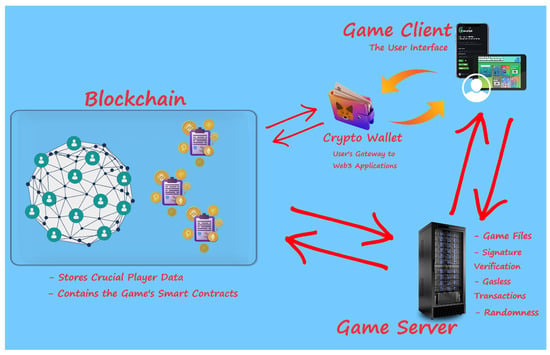
Figure 1.
The architectural framework of a blockchain game. Adapted from [22].
Starting from the game client, an interface through which players interact with the GENERA Web3 Game. The client is designed to be user-friendly and intuitive, masking the inherent complexities of blockchain. It serves as the visual and interactive layer, providing players with a seamless experience akin to traditional games while facilitating interactions with blockchain-based features.
Next is the game server, unlike conventional games where a server contains most of the game logic and data, the GENERA Web3 Game’s server plays a more nuanced role. It manages essential game logic, session management, and real-time updates, while also interfacing with the blockchain network for transaction processing and data retrieval. Critical game data, however, such as player achievements and game states, are not stored on this server but on the blockchain to ensure integrity and security.
The blockchain network, the core of the GENERA Web3 Game’s architecture, is the third component. It is the place where important records of game assets, player statistics, and other crucial data are immutably stored. This decentralized storage ensures the authenticity and permanence of in-game items, achievements, and currency.
The final component is the smart contracts, these self-executing contracts are encoded with the game’s rules and transactional protocols, thereby fostering trust and transparency. They ensure decentralized, immutable gameplay, which is vital for the game’s educational goals. Smart contracts manage in-game assets, execute transactions, and regulate player interactions, enabling autonomous and secure gameplay.
3.2. Technologies and Components
For the creation of the client component, React [29] was utilized, a well-established web development library produced by Meta (Facebook). This library is commended for its capacity to develop detailed and highly responsive user interfaces for web applications. Through the application of React, the game can be operated within a browser environment, thereby enhancing its accessibility to anyone in possession of a device with Internet browsing capabilities, eliminating the necessity for hardware with intense graphical processing capacity.
As for the game server, it leverages Node.js [30], the Express.js framework [31], and a MySQL database [32], intending to optimize the game’s performance. These technologies can bolster the other components by processing and storing data that are not considered critical. Nevertheless, these elements are vital for performing various other tasks, such as confirming a user’s digital signature using the ethers.js library [33], enabling the use of gasless transactions [34] and generating randomness in the form of a number produced by the crypto module [35] from Node.js. Regarding the gasless transactions, also known as meta-transactions, these are transactions that have the gas fee paid for by a third party instead of the transaction sender. Thirdweb [36], a modern web3 development framework, was utilized as it provides an SDK solution to insert this functionality into an application through the OpenZeppelin Defender [37] provider.
In this project, we selected GETH [38], a widely used Ethereum implementation, for its robustness and comprehensive documentation, which facilitated the development process. We employed GETH’s Proof-of-Authority (PoA) consensus protocol, ‘Clique’ [39], for its energy efficiency and ability to expedite transaction processing compared to Proof of Work (PoW) and Proof of Stake (PoS). This protocol operates with a limited number of validators, allowing for fast transaction finality and reduced resource requirements. However, it is important to note that PoA’s increased centralization [40,41], due to control residing with a few validators, can pose challenges such as potential bias or censorship.
Lastly, concerning the smart contracts, the necessary logic was divided into three separate contracts.
The first, dubbed TokenManager, is given the task of generating, preserving, and transferring the game tokens. This decentralized application employs two distinct types of tokens: the in-game gold, analogous to an ERC-20 [42] compatible token due to its resemblance to conventional currency, and the in-game cards, possessing attributes similar to an ERC-721 [43], widely referred to as NFT [43]. To manage both types of tokens within a single contract, the ERC-1155 [43] token standard was selected. This standard has become a contemporary choice across numerous other blockchain sectors due to its enhanced performance, reduced gas-related expenses, and the capability to transact multiple distinct token types in a single transaction [43].
Subsequently, there is the GameManager contract, which is responsible for maintaining all the game logic from the blockchain’s perspective. For example, a function labeled ‘createPlayer’ is invoked when a new player is generated.
Finally, the Marketplace contract, which, as the name suggests, houses all the logic pertinent to the game’s marketplace.
The contracts in this study were developed using the Solidity programming language [44], the most popular choice for developing smart contracts on Ethereum Virtual Machine (EVM) [45] compatible blockchain networks. For the testing and deployment, the Hardhat framework [46] was employed, which uses JavaScript or TypeScript.
3.3. Decentralization and Centralization: Balancing Blockchain and Game Server
In the GENERA Web3 Game, we have strategically balanced the principles of blockchain decentralization with the practicalities of using a centralized game server. This integration is crucial for optimizing game performance while maintaining the integrity and benefits of blockchain technology [22,47].
- Decentralization through Blockchain: The core of the game’s decentralization lies in its use of blockchain technology for managing critical game data. This includes player achievements, in-game asset ownership, and transaction histories. By leveraging blockchain’s immutable ledger, we ensure the integrity and permanence of these elements, which is vital for player trust and the game’s educational purpose.
- Centralized Game Server Role: While the blockchain handles crucial data, the centralized game server manages real-time game logic, session management, and non-critical data processing. This setup allows for a more efficient and responsive gaming experience, as the server can quickly process and update game states without the latency associated with blockchain transactions.
- Combining Centralization and Decentralization: The game architecture smartly integrates these two aspects. The game server handles dynamic in-game interactions and updates, while the blockchain component ensures the security and authenticity of key game elements. This dual approach allows us to utilize the strengths of both centralized and decentralized systems. For instance, real-time player interactions and game state updates are managed by the server for immediacy and responsiveness. In contrast, blockchain is used for secure, transparent, and tamper-proof storage of assets and achievements.
- Educational Aspect: This hybrid approach also plays a critical role in the game’s educational objectives. Players experience firsthand how blockchain technology can be integrated into real-world applications, understanding the balance between decentralized security and centralized efficiency. The game thus serves as a practical example of how blockchain can complement traditional systems, rather than completely replacing them.
In summary, the GENERA Web3 Game demonstrates a pragmatic use of blockchain technology in gaming, where decentralization for critical data integrity coexists with centralized systems for efficient game dynamics. This balance exemplifies a realistic and effective implementation of blockchain in gaming, providing valuable insights into its potential applications in various domains.
3.4. Story and Gameplay
The narrative of the game unfolds chronologically in 2045 and is set amidst the Mediterranean Sea islands. In this hypothetical scenario, Europe faces an energy crisis that profoundly disrupts people’s everyday lives. Government bodies, despite their utmost efforts, find it challenging to meet the energy demands of sprawling urban areas and to remedy the power shortage in more isolated regions.
The player’s role is to navigate this situation as the mayor of a small Mediterranean island town, seeking to improve the residents’ daily lives by building renewable energy generators (REGs) and using them to supply power to buildings such as hospitals, eateries, and workshops.
Players manage the townsfolk by designating them professional roles. Four are available: private sector (which generates gold), concrete gathering, metal mining, and crystal harvesting. These resources are indispensable for the creation or enhancement of REGs and Buildings.
REGs supply electrical power, while Buildings offer a range of effects. These effects span from passive ones, such as improving residents’ quality of life, to active ones, such as enabling players to upgrade the workers’ tools to accelerate resource collection. Figure 2 depicts the REGs and Buildings, which are in-game assets and are symbolized as cards. There is also a Special Effect Card type with a more abstract presence. This type of card, once activated, yields a 12 h effect boosting specific player statistics, like enhancing resource gathering rates by a percentage based on its rarity.
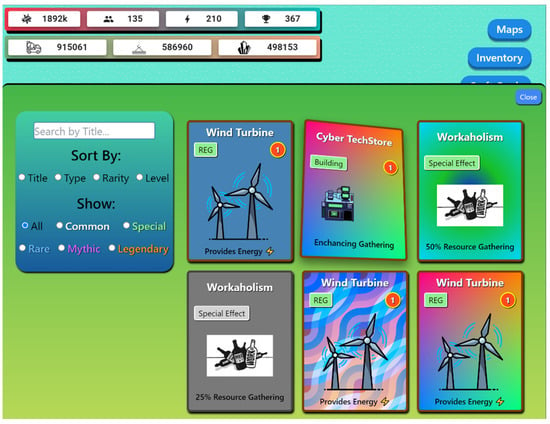
Figure 2.
The in-game virtual assets.
The game’s most significant Building is the “Town Hall”, displayed in Figure 3, present from the start, which is irremovable and unsellable. It serves as a hub for players to assess the town’s current state, such as population size, growth rate, energy production, and is the place where the job assignment is performed as shown in Figure 4 and Figure 5. Upgrading (or leveling up) the Town Hall extends the town’s capacity, allowing more REGs and Buildings to be created and more residents to be accommodated.
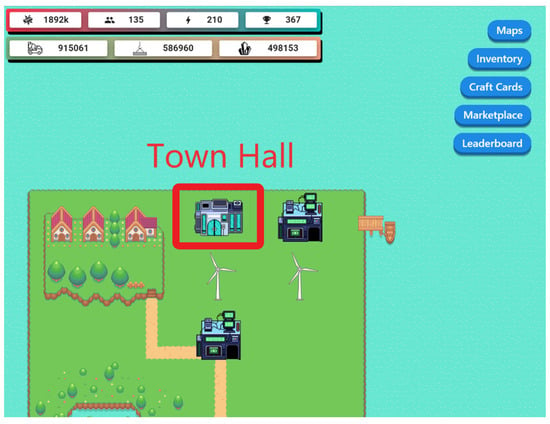
Figure 3.
The game’s town map.
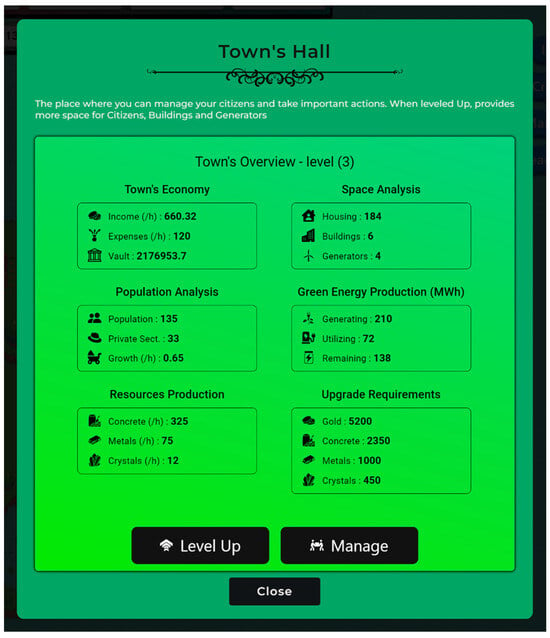
Figure 4.
The Town Hall’s Menu.
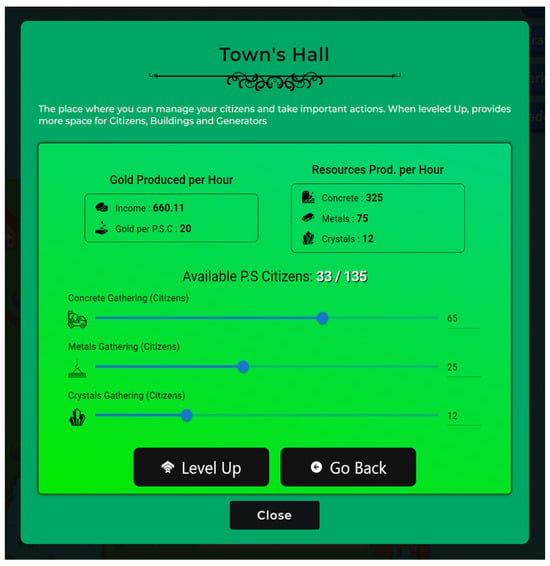
Figure 5.
The Town Hall’s Citizen Management Menu.
A pivotal game element is the living standards score, mirroring the town’s population growth rate. This score has an inverse relationship with the population; the larger the population, the more difficult further growth becomes. Specialized Buildings can enhance the living standards score, enabling sustainable population growth.
Incorporating multiplayer online features, a competitive aspect was introduced to boost player engagement. The ultimate player objective is to ascend the ranking ladder as the Ranking Score is calculated based on the town’s population and green energy output. The game’s leaderboard is presented in Figure 6. Higher leaderboard positioning yields greater rewards. In the context of our narrative, this translates to governments acknowledging the mayor’s efforts and achievements by bestowing random in-game rewards like gold, resources, or cards.
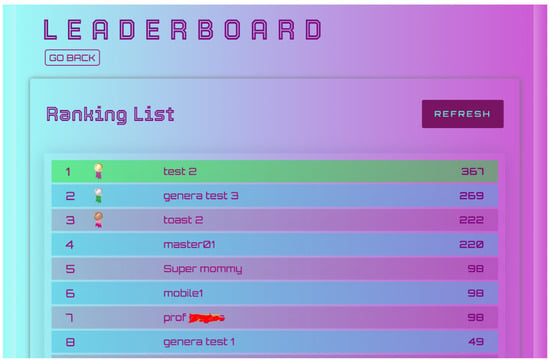
Figure 6.
The Leaderboard.
Additionally, the Marketplace, shown in Figure 7, constitutes another multiplayer feature promoting player interaction. It offers a platform for players to engage in buying and selling cards amongst themselves. This functionality adds depth to the gameplay by enabling the development of more intricate and inventive strategies.
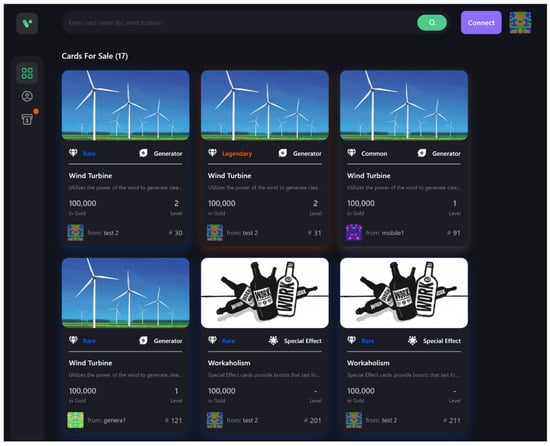
Figure 7.
The Marketplace.
3.5. Game Mechanics
In this section, details about the essential mechanisms driving the application are presented. We will introduce these key components and also undertake a detailed analysis, exploring their functionalities, their interconnections, and their roles in ensuring the overall smooth operation of the application.
Commencing with the User Interface (UI), the game loop emerges as the most significant code piece, acting as the core of the UI. This perpetual loop recalculates all new values to update the player’s statistics every 5 s and also performs safety verifications. These updates are initially stored in the device’s memory and are only moved to the blockchain after a full minute has elapsed. This design mitigates potential scaling issues, as a shorter duration would result in a rapid expansion of the network’s storage and increased processing power demand. The game is structured such that any potential loss of a few minutes due to connection errors would have an unnoticeable impact on the player’s progress. Moreover, the structure of the game does not necessitate players to keep their devices operational without interruption. After every synchronization process, a timestamp is also recorded on the blockchain. Another task of the game loop, dubbed “catch up”, is to determine the elapsed time from the player’s last session and compute the resources to be added. This functionality is embedded in the game client’s code due to its high computational demand, which could potentially lead to scalability issues if integrated into the blockchain. However, this is generally not considered a best practice, given that the game client is highly susceptible to data manipulation attacks.
User authentication forms the next vital and intriguing aspect. The login and sign-up page are displayed in Figure 8. The authentication process in decentralized applications (Dapps) strikingly contrasts with that of traditional ones. Usernames and passwords are replaced by public and private keys. During authentication, the application dispatches a message containing relevant text and a randomly generated number, shown in Figure 9, which is sourced from the game server, to the user’s crypto wallet. The wallet prompts the user to read and, if willing, sign the message. This signed message, coupled with the user’s public address, is then relayed back to the game server. Through intricate cryptographic verification methods, it can be ascertained that the public address’s possessor is indeed the account owner, thereby eliminating the need for any personal or sensitive information. Moreover, this procedure offers convenience as users require a single wallet to access all Dapps. Blockchain essentially shifts the user entity from the application’s control to the user’s hands.
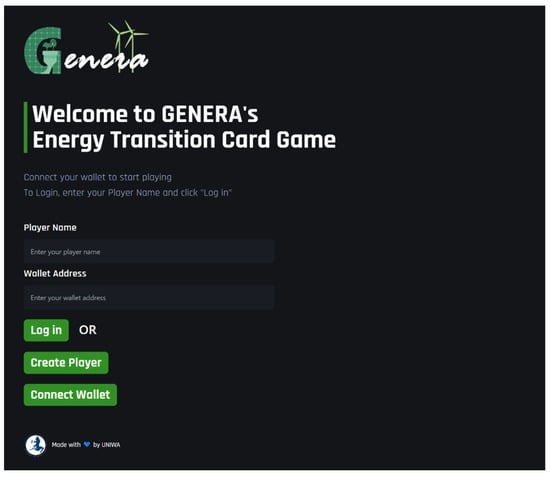
Figure 8.
Login, Sign-Up, and Wallet Connection Page.
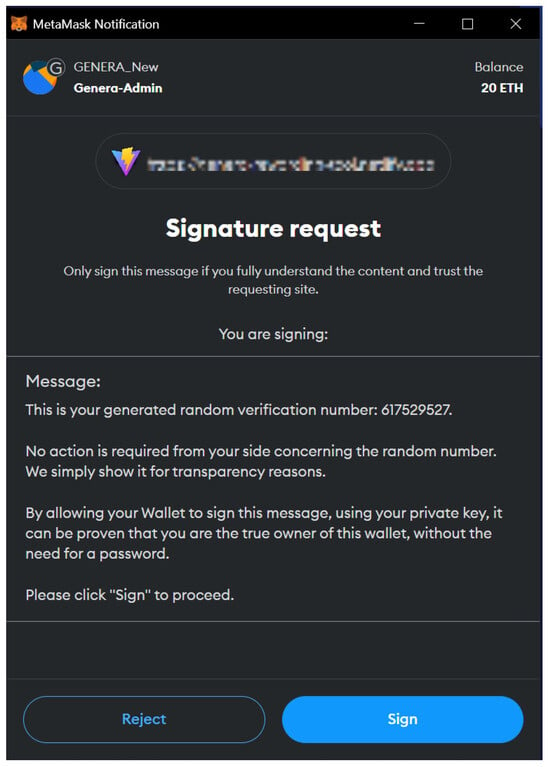
Figure 9.
Signable Message for User Authentication.
Although decentralized applications (Dapps) allow users to log in without creating an account, there are numerous instances where the application may request users to do so, typically to enhance the User Experience (UX) [48]. In the context of this project, the only requested information is an alias, which serves to address the player in a more user-friendly way, as opposed to their public address. Technically, the sign-up process entails the user selecting a username, which is then mapped to the user’s address within the smart contract. Moreover, the sign-up process is leveraged to transfer some of the network’s native currency to the player, enabling them to execute transactions that alter the state of the blockchain network.
Another significant feature is the architecture facilitating gasless transactions. This mechanism enables an external entity, typically a web server, to transmit transactions on the user’s behalf. This arrangement is crucial for two reasons. First, it automates the process of updating player statistics; without it, players would need to manually synchronize their data from the device’s memory with the smart contract. Second, it enables a user to execute the aforementioned process without spending any of their own ETH, the native currency of the network.
A pivotal feature of the game lies in the creation of uniquely ownable virtual assets. These assets are embodied in the form of in-game cards that represent the Renewable Energy Generators (REGs), Buildings, and Special Effect cards. The ownership of these digital items is managed passively through the use of the ERC-1155 contract. To ensure the uniqueness of each asset, every card token is treated as a Non-Fungible Token (NFT). In the context of an ERC-1155 contract, uniqueness is achieved by minting only a single token for a specific token ID. This strategy guarantees that even if two cards share identical metadata attributes such as type, rarity, and level, their distinct IDs make each card unique.
Before wrapping up this sub-section, it is worth delving into the handling of the ranking score and the marketplace.
The ranking score is stored as a property within the user object in the GameManager contract. Here, too, the gasless transaction approach is applied; nonetheless, an option is available for users to manually update this value if they wish. Should a player not update their ranking score within a period of five days, they stand to lose their accumulated progress. This method is designed as a form of disciplinary action to prompt the player to engage with the game consistently. This is achieved by bypassing the game loop’s “catch up” function.
As for the marketplace, a purchase is finalized through three main steps. The first involves the seller putting the card up for sale, which is accomplished by updating the forSale and price properties of the card in the GameManager contract. Furthermore, a reference is maintained in the Marketplace contract to circumvent the need for computationally expensive loop operations. The subsequent step is to display the card on the Marketplace’s UI for potential buyers to browse. Lastly, once a buyer has been found, three sub-actions are carried out. Firstly, the in-game gold tokens are transferred from the buyer to the seller by utilizing the ERC-1155′s functionality. Following that, the ownership of the card is similarly transferred, and finally, the forSale and price properties of the card are reset.
4. Results and Discussion
This section aims to present recent data gathered from the top 150 games and highlight the benefits of incorporating blockchain technology into both serious and non-serious games. Furthermore, the feedback received from the distributed questionnaires will be examined.
4.1. Analysis of Game-Related Blockchains
Tian Min [22] and colleagues carried out an extensive survey in 2019, exploring the trends in the DApp market and gathering a wealth of useful information. In the particular research endeavor, the focus was shifted into the blockchain platforms rather than the games themselves. Due to the rapid evolution of blockchain technology, it was deemed necessary to collect more recent data; therefore, data from the top 150 most popular games were drawn using the same source as Tian Min [22], namely, the DappRadar [49] web application.
DappRadar provides four key data points for each game: the supported blockchains, balance, Unique Active Wallets (UAW), and volume. ‘Balance’ refers to the total value of assets in a DApp’s smart contracts. ‘UAW’ is the number of unique active wallets interacting with or performing a transaction with a DApp’s smart contracts over a given period, in this case, one month. Lastly, ‘volume’ indicates the dollar value of incoming token transfers from unique active wallets to the DApp’s smart contracts over a set period.
Data analysis was conducted to process the gathered information and present it visually in four figures.
The insights drawn from Figure 10 indicate that among 26 popular networks, BNB Chain [50], Polygon [51], WAX [52], and Ethereum enjoy the highest number of games. Among the four, WAX is the only one specializing in gaming and employs a DPoS consensus algorithm, while the others leverage various forms of PoS algorithms.
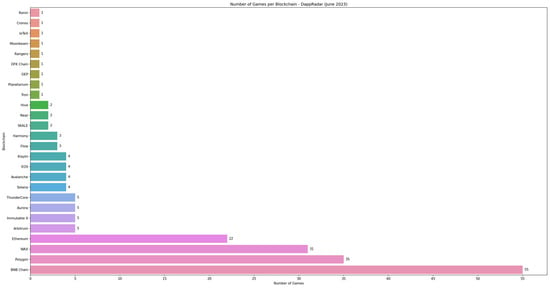
Figure 10.
The number of games per blockchain.
As shown in Figure 11, BNB Chain takes the lead in terms of unique active players as well. By examining the unique active wallets (UAWs), the presence of some emerging blockchains is revealed, particularly considering their limited availability of games. To illustrate, both Near and Hive support only two games each, yet they boast approximately 120 thousand UAWs.
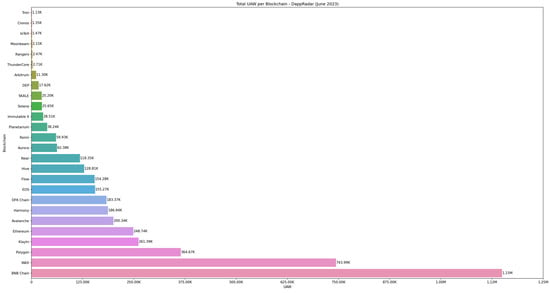
Figure 11.
The number of Unique Active Wallets (UAW) per blockchain.
Regarding the aggregate balance and volume, Ethereum tops the chart with Ronin [53] following closely behind as depicted in Figure 12 and Figure 13. Interestingly, Ronin supports just a single game, yet it ranks second in both categories. The sole game, Axie Infinity, launched in 2018, pioneered the “Play to Earn” concept [54] and is considered a landmark in the discipline’s history. This approach incentivizes players with token rewards for participating in diverse in-game activities. Initially, the Ronin platform operated using a PoA mechanism, but in response to users’ demands for more decentralization, it transitioned to a DPoS model.
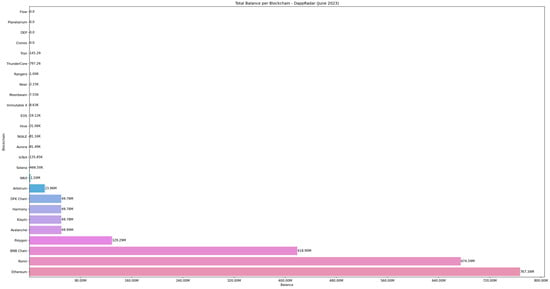
Figure 12.
The total balance in dollars of each blockchain.
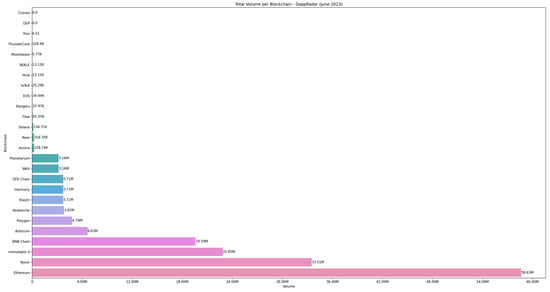
Figure 13.
The total volume in dollars of each blockchain.
The primary objective of this investigation was to equip readers and fellow researchers with up-to-date information about the current landscape of blockchain gaming, with a specific emphasis on the platforms in use. In the case of the GENERA Web3 game, the results of this study initially encouraged the development of a blockchain-based game to be used as a means to educate people about energy transition techniques. Additionally, as the popularity of Ethereum was also depicted in the game’s development field, alongside the simplicity of having a wallet and connecting to Ethereum’s MainNet, this led us to decide to use this platform for our game.
4.2. Blockchain Benefits in Gaming and Their Prospective Integration in the GENERA Web3 Game
Blockchain’s inherent characteristics seem to match the needs of the gaming industry, making this technology a very promising one for game developers. Here is a list of the benefits that blockchain technology brings to game developers:
- Auditability and Immutability: The GENERA Web3 Game’s codebase and transaction history are permanently inscribed on the blockchain, providing players with transparent access to the game’s rules and mechanics. This enhances trust in the game’s ecosystem, ensuring that the developers’ promises are verifiable and immutable.
- Fraud Prevention: The unique token system of blockchain, essential in preventing in-game asset duplication and fraud, will be a central point in the game’s next iterations. By ensuring each asset’s uniqueness, we aim to create a more secure and fair gaming ecosystem. A good comparison could be made to Counter-Strike: Global Offensive [55], where item duplication scams have been a persistent issue.
- Extendibility: The open nature of the game’s blockchain allows for extendibility, where developers can create new decentralized applications (DApps) that interact with the game’s assets. In our game, this capability is envisioned to extend its lifespan and educational impact by enabling additional functionalities like visualizing the in-game economy or transferring educational achievements to new contexts.
- Ownership of Digital Assets: Our game embodies true digital ownership, a stark contrast to traditional games where ‘ownership’ is subject to the game provider’s continued service. Blockchain ensures that players retain control over their assets, which is an essential feature for educational tools that may include certifications or digital credentials. Additionally, those assets only cease to exist if the whole blockchain shuts down, unlike traditional games where the game’s database can be deleted once the provider does not make any profit.
- Complex Economy: Subsequent versions of the game will introduce more sophisticated economic models, using blockchain to simulate real-world economic interactions and teach players about advanced financial concepts. The game’s existing marketplace will be used as a host for this feature. Examples of these are the automated market maker (AMMs) [56] systems. In a popular genre of games, MMORPGs [57], gamers struggle with the prohibition on trading in-game and real currencies. Blockchain offers players the autonomy to control their digital assets as desired.
- Elimination of Personal Data Storage: We leverage blockchain to minimize personal data collection, addressing privacy concerns. Players engage with the game using only their crypto wallet addresses, which provides a level of anonymity and security not typically found in traditional online services.
For serious games, these blockchain benefits present unique opportunities for future development:
- Credential Verification: Future iterations of the game will incorporate blockchain for tracking and validating player achievements, potentially offering digital credentials that can be recognized by educational institutions or employers.
- Soulbound Tokens for Personalized Learning Experiences: We are looking to implement soulbound tokens [58] in upcoming versions to create personalized learning experiences based on players’ in-game achievements.
- Incentivization and Engagement: The next phase will introduce token-based incentives for educational milestones, aiming to further motivate players through tangible rewards.
- Research and Data Integrity: As the game evolves, we intend to utilize blockchain to ensure the integrity of research data collected, contributing to studies on learning methods and behavioral change.
- Interoperability: We aim to enable progress tracking across multiple educational games, facilitating a seamless and continuous learning experience for players.
- Fraud Prevention and Security: Enhancing the game’s security and the legitimacy of in-game achievements through blockchain will be a key focus in our continued development, especially for educational and professional applications.
GENERA Web3 Game is designed as a practical and engaging tool to help users become familiar with the operation of blockchain-based applications. By immersing players in interactive gameplay, it guides them through the nuances of blockchain navigation and functionality, making the learning process both informative and enjoyable. Players are requested to perform the following tasks before accessing the game:
- Download, install, and set up one of the most widely used cryptocurrency wallets, MetaMask [59].
- Insert the project’s PoA blockchain network and in-game tokens into their wallet.
- Connect their wallet to the game client, to allow the web application to communicate with the user’s wallet.
- Create an in-game account, by simply providing an alias and initiating a transaction to update the blockchain’s state. The gasless transaction technique is employed as the user does not yet possess any of the network’s ETH to perform the transaction.
- Login using their wallet’s private key to sign a message that is used to prove the user’s ownership over the particular public address.
Additionally, through the game’s marketplace, players are able to familiarize themselves with one of the most popular use cases of blockchain-powered applications, the NFT exchange.
By integrating these blockchain benefits into the GENERA Web3 Game, we not only bolster the game’s educational value but also contribute to the evolving discussion on blockchain’s multifaceted role in enhancing serious gaming experiences.
4.3. Survey Analysis
In order to measure the level of public awareness and understanding of blockchain technology, a survey was conducted as part of this study. The survey aimed to assess participants’ familiarity with blockchain concepts, their perceptions of the technology’s applications, and their views on its potential impact on various industries. Additionally, it draws upon related research, including the study conducted by Iikka Paajala et al., which focused on player retention and engagement in blockchain games, to provide a comprehensive overview of the relationship between public awareness and gaming experiences in blockchain-based environments [28]. By analyzing the survey’s results and comparing them to existing studies, this section offers valuable insights into the role of education and awareness in fostering broader acceptance and utilization of blockchain technology in gaming and beyond.
The survey comprises 19 questions and includes sections that provide background knowledge for participants unfamiliar with blockchain technology. The corresponding link can be found in the Supplementary Materials Section. It is divided into two parts: the first part aims to assess participants’ awareness of blockchain and their willingness to learn and engage with the technology, while the second part focuses on their experience with the GENERA Web3 Game. A total of 15 responses were collected, with 10 participants having no prior acquaintance with blockchain technology, 3 possessing some basic knowledge, and 2 displaying a high-level understanding of its functionalities.
Upon inquiring about their familiarity with the term “cryptocurrency”, 80% of the participants responded affirmatively. However, when asked about their knowledge of “crypto-wallets” or “public and private keys”, only 33.3% of the respondents answered positively. This discrepancy suggests that while a significant portion of the participants may have heard of cryptocurrencies, their understanding of the technical aspects, such as crypto-wallets and key management, appears to be limited. This finding underscores the importance of providing educational resources and explanations in the survey’s sections to enhance participants’ comprehension of blockchain technology and its associated concepts.
The subsequent four questions inquired about the fundamental traits of blockchain technology, aiming to determine which aspects of the technology deter the general public from considering its usage. The gathered data, as depicted in Table 1, provide valuable insights into participants’ perceptions.

Table 1.
General public’s sentiment evocation from blockchain technology usage.
From the data, it is evident that when it comes to decentralization, the majority of the participants expressed indifference toward whether the network is decentralized or not. Two participants reported feeling insecure about this feature, while the remaining respondents exhibited enthusiasm and excitement for the concept of decentralization.
The data collected on blockchain’s enhanced security reveal a unanimous positive sentiment among all participants. This widespread positive perception highlights the recognition of blockchain’s robust security features, which are often considered one of its main advantages.
On the other hand, when it comes to transparency, the data portray a more complex scenario. Only five participants viewed transparency as a positive trait, while the majority of respondents either expressed fear or insecurity about it.
Privacy and trustlessness share the same level of positive appreciation as enhanced security, which also indicates a noteworthy aspect of blockchain technology. However, the contrasting response regarding transparency suggests that there might be a misconception or misunderstanding surrounding the term itself, rather than its actual benefits or effects.
This observation underscores the importance of educational efforts to bridge the gap in public understanding and perception of transparency. By providing clear and accessible explanations of how transparency can enhance security, accountability, and data integrity, the general public can gain a more informed perspective on the benefits it brings. Additionally, highlighting real-world-use cases where transparency has proven advantageous can help dispel any unfounded fears or insecurities associated with the concept.
The rest of the questions are presented as figures, from Figure 14, Figure 15 and Figure 16, directly extracted from the Google Forms survey. Each figure displays a graph of the collected results as well as the original question located at its caption.
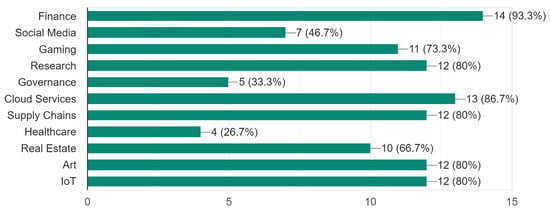
Figure 14.
Perceived Beneficial Sectors for Blockchain Technology Adoption.

Figure 15.
Interest in Watching an Educational Video about Blockchain-Powered Apps: (1) Not at all, (2) Slightly likely, (3) Fairly Likely, (4) Likely (5) Very likely.
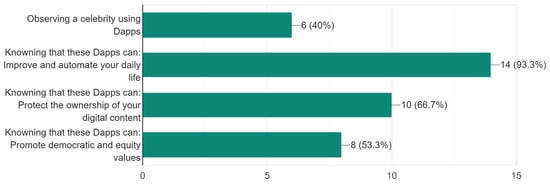
Figure 16.
Motivation to Learn and Utilize Blockchain-Powered Applications.
With the assessment of participants’ understanding and perceptions of blockchain technology completed, the survey now delves into the second part, focusing on the developed game. The rest of this section aims to gather insights into participants’ experiences and interactions with the blockchain-based card game centered around renewable energy and sustainable resource management. By exploring their feedback and observations, we can gain a deeper understanding of the game’s impact and potential in bridging the gap between entertainment and education, as well as its role in showcasing blockchain’s applicability in the gaming industry.
Based on the information displayed in Figure 17, it becomes evident that the majority of the participants spent less than 10 min playing the developed game, while the rest dedicated around 30 min to it. These findings indicate a need for significant improvements to enhance player retention and engagement within the game. The data presented in Figure 18 highlight participants’ dissatisfaction with aspects such as the lack of high-quality graphics, in-game features, and available content. These results corroborate the findings of Iikka Paajala et al. [21], emphasizing the importance of not solely focusing on blockchain integration but also giving substantial attention to game graphics and mechanics in the development of a blockchain game.
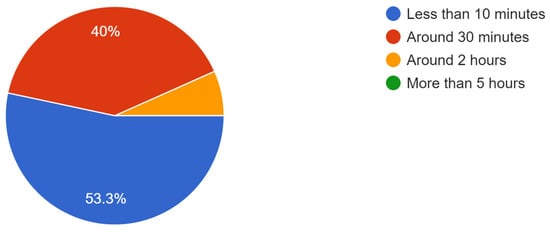
Figure 17.
Time Spent on the Game.

Figure 18.
Game Improvements Feedback.
The following figures (Figure 19, Figure 20 and Figure 21) offer valuable insights into participants’ experiences with the game as a Dapp. These figures provide a comprehensive overview of their experience with the Dapp, including the process of setting up a crypto wallet, managing custom tokens and networks, and user authentication using digital signatures.

Figure 19.
Crypto wallet Installation and Navigation: (1) Was unable to do it, (2) Made it with help, (3) Slightly Easy, (4) Fairly Easy, (5) Piece of cake.

Figure 20.
Custom Tokens and Network Insertion: (1) Was unable to do it, (2) Did it with help from a friend, (3) Didi it fairly easy, (4) Did it easily, (5) Piece of cake.

Figure 21.
Web3 User Authentication: (1) Prefer the traditional way, (2) Needed Help, (3) Fairly Easy to do it, (4) Easily did it, (5) Incredible! Fast and convenient.
The data reveal that participants found the procedure of setting up a crypto wallet to be relatively easy compared to the management of custom tokens and networks. This observation aligns with the expected behavior, as crypto wallets are external stand-alone applications designed to handle digital assets, and they often provide APIs for Dapp developers to enhance user experience. However, the efficiency of utilizing these APIs and integrating them seamlessly into the Dapp’s user interface largely depends on the Dapp’s development team.
Regarding the aspects of true asset ownership and fraud prevention, all candidates expressed a positive response, evoking a sense of enthusiasm among them.
In the final two questions of the survey, participants were asked about their interest in two potential developments for the game. The first question inquired about their interest in the incorporation of AI-powered features in the forthcoming game update, while the second question asked about their interest in the development of another Dapp that would provide a rewarding system for other Dapps to utilize. The responses from all participants were overwhelmingly positive, indicating a keen interest in both potential developments.
5. Conclusions and Future Plans
As this research study draws to a close, the authors aim to communicate their interpretations from the feedback obtained via surveys. They also recommend potential upgrades and uses that could widen this project’s reach and contribute significantly to the progression of the field under exploration.
In relation to the game, the respondents suggested that an improvement in the game’s graphical components could potentially enhance player involvement and retention. To address this, the authors recommend the adoption of an AI tool for image generation, such as Dall-e 2 [60] from OpenAI [61] or Midjourney [62], to elevate the game’s visual elements.
Survey participants voiced their concern over the limited array of cards and in-game features, which, in their view, restricts the time they can spend engaging with the game. Plans are underway to tackle the issue of card variety. For the dearth of in-game features, once more, generative AI tools can be used to tackle the issue. Tools like OpenAI’s ChatGPT [63] and Google’s BARD [64] can help in creating AI-generated game content. The authors propose using these tools to formulate questions aimed at enhancing awareness about renewable energy and resource management. The system should be designed in such a way that users should use their critical thinking skills to respond. Once submitted, the AI would score the response from 0 to 10, and the game would then use this score to reward or penalize the player accordingly.
Regarding the discipline of blockchain gaming as a whole, launching the game’s smart contract on diverse blockchain networks with varying features could shed light on the factors influencing the game’s overall performance and experience. A comprehensive list of popular blockchain platforms utilized for gaming has been provided in the previous section. A quite unique and underexplored consensus protocol, the Proof-of-Play (PoP) [65], would be an intriguing subject for research.
Moreover, taking advantage of the blockchain’s capability to extend a DApp’s functionality by creating new DApps, the authors propose the development of a rewards application. This application would allow other DApps, such as this game, to interact with it. It would manage its own tokens, with their utility only limited by the creator’s creativity. Some suggestions could include rewarding players when they create a new card, upgrading the TownHall building, or completing a card exchange in the marketplace. Furthermore, the rewards DApp could enable the conversion of its tokens into in-game gold tokens, offering a real-world simulation of cryptocurrency exchange.
This research illuminated the profound implications of blockchain technology and DApps on gaming engagement and innovation. Participant feedback confirmed the vast potential for growth in this domain. As blockchain and AI evolve, they will continue to revolutionize gaming. We extend our thanks to the participants and the broader gaming and blockchain communities, whose contributions were vital for this research. We are eager to further investigate this exciting field.
Supplementary Materials
Readers interested in participating in or viewing the questionnaire related to this research can access it at: https://docs.google.com/forms/d/1_YyLLX1zGdvXesovUm-vcAQGSyAhzkE1Jo-IEHp-cl8.
Author Contributions
Conceptualization, D.S., D.G.K. and H.C.L.; methodology, D.S., P.P. and D.G.K.; software, D.S.; validation, D.S., P.A.K. and D.G.K.; formal analysis, D.S. and P.P.; investigation, D.S. and P.P.; resources, D.S. and D.G.K.; data curation, D.S.; writing—original draft preparation, D.S.; writing—review and editing, D.S. and D.G.K.; visualization, D.S.; supervision, P.A.K. and D.G.K.; project administration, H.C.L.; funding acquisition, H.C.L. All authors have read and agreed to the published version of the manuscript.
Funding
This research was funded by European Union Programme for the Environment and Climate Action (LIFE-2023-CET) under the GENERA project, grant number 81150.
Data Availability Statement
The data presented in this study are available on request from the corresponding author after the completion of the research project.
Conflicts of Interest
The authors declare no conflicts of interest.
References
- Fowler, A.; Pirker, J. Tokenfication—The potential of non-fungible tokens (NFT) for game development. In Proceedings of the Extended Abstracts of the 2021 Annual Symposium on Computer-Human Interaction in Play (CHI PLAY ’21), Virtual Event, Austria, 18–21 October 2021. [Google Scholar]
- Xevgenis, M.; Kogias, D.G.; Karkazis, P.A.; Leligou, H.C. Addressing ZSM Security Issues with Blockchain Technology. Future Internet 2023, 15, 129. [Google Scholar] [CrossRef]
- Kogias, D.; Leligou, H.C.; Xevgenis, M.; Polychronaki, M.; Katsadouros, E.; Loukas, G.; Heartfield, R.; Patrikakis, C.Z. Towards a Blockchain-enabled Crowdsourcing platform. Int. J. Hum. Comput. Interact. 2019, 21, 18–25. [Google Scholar] [CrossRef]
- Pfeiffer, A.; Kriglstein, S.; Wernbacker, T. Blockchain Technologies and Games: A Proper Match? In Proceedings of the International Conference on the Foundations of Digital Games (FDG ’20), Bugibba, Malta, 15–18 September 2020. [Google Scholar]
- Naavik. CoinMarketCap and Naavik: 2022 Blockchain Gaming Report—New Frontiers and the Path Forward. CMC Res. November 2022. Available online: https://coinmarketcap.com/alexandria/article/coinmarketcap-and-naavik-2022-blockchain-gaming-report-new-frontiers-and-the-path-forward (accessed on 18 July 2023).
- Agrawal, G. Examples of Blockchain Games (and How They Work). Medium 8 January 2019. Available online: https://medium.com/crowdbotics/examples-of-blockchain-games-and-how-they-work-7fb0a1e76e2e (accessed on 18 July 2023).
- Yao, W.; Ye, J.; Murimi, R.; Wang, G. A Survey on Consortium Blockchain Consensus Mechanisms. arXiv 2021, arXiv:2102.12058. [Google Scholar]
- Ismail, L.; Materwala, H. A Review of Blockchain Architecture and Consensus Protocols: Use Cases, Challenges, and Solutions. Symmetry 2019, 11, 1198. [Google Scholar] [CrossRef]
- Khan, S.; Loukil, F.; Ghedira, C.; Benkhelifa, E.; Bani-Hani, A. Blockchain Smart Contracts: Applications, Challenges, and Future Trends. Peer-Peer Netw. Appl. 2021, 14, 2901–2925. [Google Scholar] [CrossRef] [PubMed]
- Liapis, A.; Katsanos, C.; Karousos, N.; Xenos, M.; Orphanoudakis, T. User Experience Evaluation: A Validation Study of a Tool-based Approach for Automatic Stress Detection Using Physiological Signals. Int. J. Hum. Comput. Interact. 2021, 37, 470–483. [Google Scholar] [CrossRef]
- Xevgenis, M.; Kogias, D.G.; Karkazis, P.; Leligou, H.C.; Patrikakis, C. Application of blockchain technology in dynamic resource management of next generation networks. Information 2020, 11, 570. [Google Scholar] [CrossRef]
- Hoque, F.; Yasin, R.M.; Sopian, K. Mobile Learning to promote Renewable Energy Ed-ucation at the Secondary Education level in developing countries. IOP Conf. Ser. Mater. Sci. Eng. 2023, 1278, 012017. [Google Scholar] [CrossRef]
- Kersánszki, T.; Holik, I.; Márton, Z. Minecraft Game as a New Opportunity for Teaching Renewable Energy Topics. Int. J. Eng. Educ. 2023, 13, 16–29. [Google Scholar] [CrossRef]
- Choi, E.; Choi, Y.; Park, N. Development of Blockchain Learning Game-Themed Education Program Targeting Elementary Students Based on ASSURE Model. Sustainability 2022, 14, 3771. [Google Scholar] [CrossRef]
- Lian, J. Digital Badges as A Gamification Tool in School-Based Assessments: An Exploratory Study of Blockchain and Smart Contracts in Primary and Secondary Education (WIP); Ministry of Education Malaysia, Kementerian Pendidikan Malaysia: Putrajaya, Malaysia, 2022. [CrossRef]
- Prawiyogi, A.G.; Aini, Q.; Santoso, N.P.L.; Lutfiani, N.; Juniar, H.L.J. Blockchain Education Concept 4.0: Student-Centered iLearning Blockchain Framework. J. Teknol. Pendidik. 2021, 23, 129–145. [Google Scholar] [CrossRef]
- Thomas, A.; Pfeiffer, A. Gallery Defender: Integration of Blockchain Technologies into a Serious Game for Assessment: A Guideline for Further Developments. In Disruptive Technologies in Media, Arts and Design; vol. 382 of Lecture Notes in Networks and Systems; Dingli, A., Pfeiffer, A., Serada, A., Bugeja, M., Bezzina, S., Eds.; Springer: Cham, Switzerland, 2022; pp. 43–53. [Google Scholar] [CrossRef]
- Gao, Y. An empirical study on the adoption of blockchain-based games from users’ perspectives. Electron. Libr. 2021, 39, 596–614. [Google Scholar] [CrossRef]
- Jiang, Y.; Min, T.; Fan, S.; Tao, R.; Cai, W. Towards Understanding Player Behavior in Blockchain Games: A Case Study of Aavegotchi. In Proceedings of the 17th International Conference on the Foundations of Digital Games, Athens, Greece, 5–8 September 2022. [Google Scholar]
- Averin, A.; Samartsev, A. Review of blockchain in computer games. AIP Conf. Proc. 2023, 2910, 020033. [Google Scholar] [CrossRef]
- Paajala, I.; Nyyssola, J.; Mattila, J.; Karppinen, P. Users’ Perceptions of Key Blockchain Features in Games. Future Internet 2022, 14, 321. [Google Scholar] [CrossRef]
- Min, T.; Wand, H.; Guo, Y.; Cai, W. Blockchain games: A survey. In Proceedings of the IEEE Conference on Games (CoG), London, UK, 20–23 August 2019. [Google Scholar]
- Arif, Y.M.; Pradana, R.P.; Nurhayati, H.; Nugroho, S.M.S.; Hariadi, M. A Blockchain-Based Multiplayer Transaction for Tourism Serious Game. In Proceedings of the International Conference on Computer Engineering, Network, and Intelligent Multimedia (CENIM), Surabaya, Indonesia, 17–18 November 2020. [Google Scholar]
- Mittal, A.; Gupta, M.P.; Chaturvedi, M.; Chansarkar, S.R.; Gupta, S. Cybersecurity Enhancement through Blockchain Training (CEBT)—A serious game approach. Int. J. Inf. Manag. Data Insights 2021, 1, 100001. [Google Scholar] [CrossRef]
- Djaouti, D.; Alvarez, J.; Jessel, J. Classifying serious games: The G/P/S model. In Handbook of Research on Improving Learning and Motivation through Educational Games: Multi-Disciplinary Approaches; France, T., Ed.; IGI Global: Hershey, PA, USA, 2011. [Google Scholar]
- Michael, D.; Chen, S. Serious Games: Games That Educate, Train, and Inform; Thomson Course Technology: Boston, MA, USA, 2005. [Google Scholar]
- Prensky, M. Digital Game-Based Learning; Paragon House: St. Paul, MN, USA, 2007. [Google Scholar]
- “GENERA”, GENERA Project. Available online: https://life-genera.eu/ (accessed on 18 July 2023).
- “React”, Meta. Available online: https://react.dev (accessed on 18 July 2023).
- “NodeJS”, Node.js. Available online: https://nodejs.org/en (accessed on 18 July 2023).
- “ExpressJS”, Express. Available online: https://expressjs.com (accessed on 18 July 2023).
- “MySQL”, MySQL. Available online: https://www.mysql.com (accessed on 18 July 2023).
- “ethers.js”, ethers.js. Available online: https://docs.ethers.org/v6 (accessed on 18 July 2023).
- Blum, F.; Severin, B.; Hettmer, M.; Hückinghaus, P.; Gruhn, V. Building Hybrid DApps using Blockchain Tactics—The Meta-Transaction Example. In Proceedings of the 2020 IEEE International Conference on Blockchain and Cryptocurrency (ICBC), Toronto, ON, Canada, 3–6 May 2020; pp. 1–5. [Google Scholar] [CrossRef]
- “Crypto Module”, Node.js. Available online: https://nodejs.org/api/crypto.html (accessed on 18 July 2023).
- “thirdweb”, thirdweb. Available online: https://thirdweb.com/ (accessed on 18 July 2023).
- “OpenZeppelin Defender”, OpenZeppelin. Available online: https://www.openzeppelin.com/defender (accessed on 18 July 2023).
- “Go Ethereum (Geth)”, Go Ethereum GitHub. Available online: https://github.com/ethereum/go-ethereum (accessed on 18 July 2023).
- Naves, C.; Glock, S.; Verdier, F.; Guitton, P. Choice of Ethereum Clients for Private Blockchain: Assessment from Proof of Authority Perspective. In Proceedings of the 2021 IEEE International Conference on Blockchain and Cryptocurrency (ICBC) 2021, Sydney, Australia, 3–6 May 2021; pp. 1–5. [Google Scholar] [CrossRef]
- Wu, X.; Chang, J.; Ling, H.; Feng, X. Scaling Proof-of-Authority Protocol to Improve Performance and Security. Peer-Peer Netw. Appl. 2022, 15, 2633–2649. [Google Scholar] [CrossRef]
- Islam, M.M.; In, H.P. Decentralized Global Copyright System Based on Consortium Blockchain with Proof-of-Authority. TechRxiv, 2021; preprint. [Google Scholar] [CrossRef]
- “ERC-20”, Ethereum. Available online: https://ethereum.org/en/developers/docs/standards/tokens/erc-20/ (accessed on 18 July 2023).
- Madine, M.; Salah, K.; Jayaraman, R.; Zemerly, J. NFTs for Open-Source and Commercial Software Licensing and Royalties. IEEE Access 2023, 11, 8734–8746. [Google Scholar] [CrossRef]
- “Solidity”, Ethereum. Available online: https://soliditylang.org/ (accessed on 18 July 2023).
- Wood, D.G. Ethereum Yellow Paper. Ethereum. Available online: https://ethereum.github.io/yellowpaper/paper.pdf (accessed on 1 December 2023).
- “Hardhat”, Hardhat. Available online: https://hardhat.org/ (accessed on 18 July 2023).
- Patrikakis, C.; Leligkou, H.; Kogias, D. Blockchain. Postgraduate textbook. Kallipos, Open Academic Editions. 2023. Available online: https://repository.kallipos.gr/handle/11419/9130 (accessed on 18 July 2023).
- Dillon, A. User Interface Design. 2006. Available online: https://onlinelibrary.wiley.com/doi/10.1002/0470018860.s00054 (accessed on 18 July 2023).
- “DappRadar”, DappRadar. Available online: https://dappradar.com/ (accessed on 18 July 2023).
- Binance. BNB Chain Whitepaper. Binance. 2019. Available online: https://github.com/bnb-chain/whitepaper/blob/master/WHITEPAPER.md/ (accessed on 18 July 2023).
- Labs, P. Polygon Whitepaper. Polygon Labs. 2017. Available online: https://polygon.technology/papers/pol-whitepaper (accessed on 18 July 2023).
- Worldwide Asset eXchange (WAX). WAX Whitepaper. WAX. 2019. Available online: https://github.com/worldwide-asset-exchange/whitepaper/ (accessed on 18 July 2023).
- Ronin. Ronin Whitepaper. Ronin. 2017. Available online: https://docs.roninchain.com/docs/basics/white-paper (accessed on 18 July 2023).
- Shimron, L. “Axie Infinity”, Forbes. Available online: https://www.forbes.com/sites/leeorshimron/2022/08/13/axie-infinity-pernicious-pyramid-scheme-or-gaming-breakthrough/?sh=3938842174b3 (accessed on 18 July 2023).
- Nguyen, P. Easy Skins, Easy Life: A Chronological Case Study of Loot Boxes and Transferable Cosmetic Items in the Video Game Counter-Strike: Global Offensive. Master’s Thesis, University of Ontario Institute of Technology (Ontario Tech University), Oshawa, ON, Canada, 2022. Available online: https://ir.library.ontariotechu.ca/bitstream/handle/10155/1587/Nguyen_Phillip.pdf?sequence=1&isAllowed=y (accessed on 1 December 2023).
- Xu, J.; Paruch, K.; Cousaert, S.; Feng, Y. SoK: Decentralized Exchanges (DEX) with Automated Market Maker (AMM) Protocols. ACM Comput. Surv. 2023, 55, 238. [Google Scholar] [CrossRef]
- Feng, W.; Brandt, D.; Saha, D. A long-term study of a popular MMORPG. In Proceedings of the 6th ACM SIGCOMM Workshop on Network and System Support for Games (NetGames ‘07), Melbourne, Australia, 19–20 September 2007; pp. 19–24. [Google Scholar] [CrossRef]
- Weyl, E.G.; Ohlhaver, P.; Buterin, V. Decentralized Society: Finding Web3’s Soul. 10 May 2022. Available online: https://ssrn.com/abstract=4105763 (accessed on 1 December 2023).
- “MetaMask”, MetaMask. Available online: https://metamask.io/ (accessed on 18 July 2023).
- “DALL-E 2”, OpenAI. Available online: https://www.openai.com/dall-e-2/ (accessed on 18 July 2023).
- “OpenAI”, OpenAI. Available online: https://www.openai.com/ (accessed on 18 July 2023).
- “Midjourney”, MidJouney. Available online: https://www.midjourney.com/home/ (accessed on 18 July 2023).
- “ChatGPT”, OpenAI. Available online: https://openai.com/blog/chatgpt (accessed on 18 July 2023).
- “Google BARD”, Google. Available online: https://www.digitaltrends.com/computing/how-to-use-google-bard (accessed on 18 July 2023).
- Yuen, H.Y.; Wu, F.; Cai, W.; Chan, H.C.B.; Yan, Q.; Leung, V.C.M. Proof-of-Play: A Novel Consensus Model for Blockchain-based Peer-to-Peer Gaming System. In Proceedings of the 2019 ACM International Symposium on Blockchain and Secure Critical Infrastructure (BSCI ‘19), Auckland, New Zealand, 8 July 2019; pp. 19–28. [Google Scholar] [CrossRef]
Disclaimer/Publisher’s Note: The statements, opinions and data contained in all publications are solely those of the individual author(s) and contributor(s) and not of MDPI and/or the editor(s). MDPI and/or the editor(s) disclaim responsibility for any injury to people or property resulting from any ideas, methods, instructions or products referred to in the content. |
© 2024 by the authors. Licensee MDPI, Basel, Switzerland. This article is an open access article distributed under the terms and conditions of the Creative Commons Attribution (CC BY) license (https://creativecommons.org/licenses/by/4.0/).